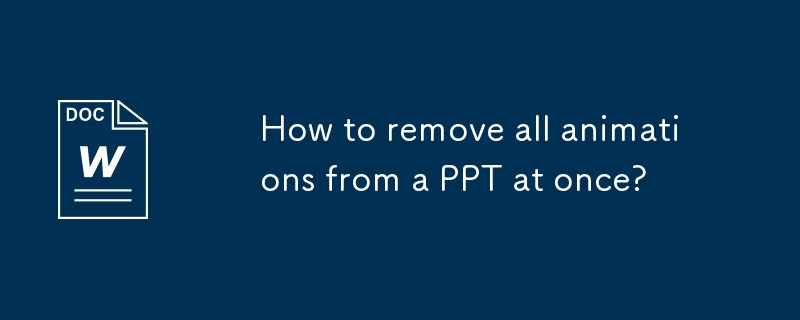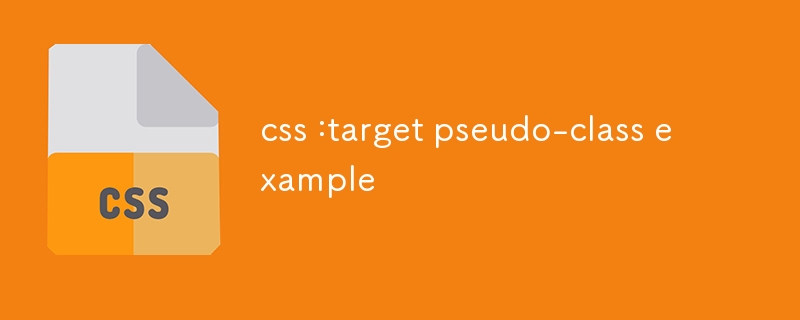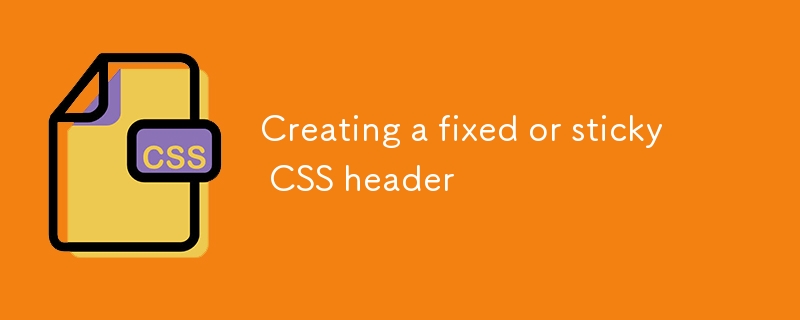Found a total of 10000 related content

HTML5 page transition effects
Article Introduction:The page switching effect can be achieved through the combination of CSS3 and JavaScript. The specific steps are: 1. Use CSS to define transition styles, such as transition or animation attributes to control page entry and exit animation; 2. Dynamically add or remove class names during page switching through JavaScript to achieve animation triggering and content updates; 3. Pay attention to optimization of performance, avoid layout jitter, and reasonably use hardware acceleration and resource preloading. In addition, you can also use global containers to manage transitions uniformly, use CSS variables to improve flexibility, and set diversified animations for different pages, so as to achieve rich and smooth page switching effects while ensuring user experience.
2025-07-23
comment 0
543

How to remove all animations from a PPT at once?
Article Introduction:To remove all animations in PowerPoint at once, you need to use VBA macros; 1. Press Alt F11 to open the VBA editor; 2. Insert a new module and paste the provided RemoveAllAnimations code; 3. Press F5 to run the macros to clear all animation effects; in addition, you need to manually go to the "Switch" tab and click "All Apps" and select "None" to completely remove the slide switching effect. This method can efficiently process long presentations, be sure to save the file before operation.
2025-08-03
comment 0
626

What is the process of making H5 pages
Article Introduction:The H5 page production process is divided into three stages: design, coding, testing and online. The design stage requires determining the user experience, visual effects and interaction details. The encoding stage uses HTML5, CSS3 and JavaScript technology stacks, focusing on responsive design, JavaScript framework and animation effects. The testing and online stages include compatibility testing, abnormal situation testing and post-online monitoring.
2025-04-06
comment 0
262

What is the CSS :target pseudo-class used for?
Article Introduction:CSS's :target pseudo-class is used to match and style target elements in the page based on the URL's fragment identifier (last part). 1. It is often used to highlight the page area that users jump to through anchor links, such as highlighting the target section through background color or border; 2. It can be used for simple tab pages or accordion effects without JavaScript, and control the display and hiding of the target elements through display attributes; 3. It can combine transition to achieve smooth animation effects when target switching; 4. It only takes effect when the URL fragment matches the element id, and does not affect the browser's default scrolling behavior, and is not supported but elegantly downgraded in old browsers such as IE8 and below.
2025-07-19
comment 0
266

How to create a CSS-only animated toggle switch?
Article Introduction:To create a CSS-only animation switch, you need to build the basic HTML structure first, and use hidden checkbox and label to simulate the switch; 2. Set container size through CSS, hide input boxes, design slider tracks and circular sliders, and add transition effects; 3. Use the checked pseudo-class to change the background color and slider position when selected, and use translateX (26px) to achieve smooth movement; 4. Optionally add box-shadow to improve visual contrast; finally realize a toggle switch that does not require JavaScript, is accessible, responsive and smooth animation, suitable for various switching scenarios.
2025-08-04
comment 0
765

H5 page making tips
Article Introduction:How to make a cool and easy-to-use H5 page: Learn about the role of the three musketeers of HTML5, CSS3 and JavaScript. Use CSS3 animations and JavaScript animations to create animation effects. Responsive design allows the page to be displayed perfectly on different devices. Use JavaScript to achieve interactive effects and improve user experience. Optimize images to reduce loading time. Improve page performance through performance optimization. Learn more, practice more, accumulate experience, and create a stunning H5 page.
2025-04-06
comment 0
1148

How to use the canvas element in HTML?
Article Introduction:How to draw graphics and implement animations in HTML5 Canvas? 1. Insert tags in HTML and set id and size; 2. Get the canvas element through JavaScript and create a 2D drawing context; 3. Use fillRect, strokeRect, arc and other methods to draw shapes; 4. Use fillText to add text and drawImage to draw pictures; 5. Use clearRect to clear the canvas and combine requestAnimationFrame to achieve animation effects. Master these basic operations and start drawing and animation development using Canvas.
2025-07-10
comment 0
253

What is requestAnimationFrame
Article Introduction:requestAnimationFrame (rAF) is more suitable for animation than setTimeout or setInterval because it is synchronized with the browser refresh mechanism to achieve smoother and more efficient animation effects. ① rAF will call the specified function before the next repaint of the browser, usually execute at a frequency of 60 frames per second to make the animation smoother; ② When the tab page is not in the foreground, it will automatically pause and save resources; ③ When using it, start the animation loop by recursively calling requestAnimationFrame and stop avoiding memory leaks under appropriate conditions; ④ Pay attention to avoid frequent operation of DOM, it is recommended to use high-performance properties such as transform and use the timestamps received by the callback function for precise control; ⑤
2025-07-03
comment 0
206

Learning resources for H5 page production
Article Introduction:To learn H5 page production, you need to master the three musketeers of HTML, CSS, and JavaScript, and to deeply study the new features of HTML5, CSS selector, layout, animation and other knowledge, master the basics and libraries of JavaScript. Advanced skills include animation effects, responsive design, and server interaction. If you encounter problems, you can use search engines, technology communities, and developer consultation to solve them. Continuously learn new technologies and maintain competitiveness, select suitable learning resources, and persist in practicing is the key.
2025-04-06
comment 0
1168

What is the :target pseudo-class and how can it be used?
Article Introduction:CSS's :target pseudo-class is used to style the target element based on the URL fragment identifier. It works by the browser scrolling to the element when the URL contains a # symbol and element id and allows a specific style to be applied to the element via :target. Common use cases include highlighting the page section after navigation, creating tabs or slideshows without JavaScript, and improving accessibility to long pages. Usage tips include ensuring that id is unique, combining transition or animation effects, switching content visibility with display attributes, and considering compatibility with older browsers.
2025-06-22
comment 0
729

What exactly does H5 page production mean?
Article Introduction:H5 page production refers to the creation of cross-platform compatible web pages using technologies such as HTML5, CSS3 and JavaScript. Its core lies in the browser's parsing code, rendering structure, style and interactive functions. Common technologies include animation effects, responsive design, and data interaction. To avoid errors, developers should be debugged; performance optimization and best practices include image format optimization, request reduction and code specifications, etc. to improve loading speed and code quality.
2025-04-06
comment 0
1494

Creating Interactive HTML Prototypes
Article Introduction:The key to making interactive HTML prototypes is to master the coordination of structure, style and behavior. 1. Use basic HTML to build structures, such as buttons and pop-up elements; 2. Use CSS to control state changes, replace frequent DOM operations through class switching, improve debugging efficiency; 3. Use native JS to achieve simple interaction, such as clicking to show or hide elements, keep the code lightweight; 4. Add animation effects to improve the experience, such as pop-ups fade in and out, but avoid excessive complexity. Through these steps, you can quickly verify ideas and demonstrate a clear process.
2025-07-26
comment 0
683

JavaScript Accessibility Best Practices with ARIA
Article Introduction:To ensure that JavaScript functions are available to all users, four key practices must be followed: 1. Use aria-live attribute to notify screen readers of dynamic content updates, distinguishing between polite and assertive levels; 2. Clear custom control behavior through ARIA role and state attributes, and keeping state synchronized; 3. Implement keyboard navigation support, including Tab focus switching and Enter/Space key triggering operations; 4. Avoid excessive use of ARIA, and give priority to HTML5 semantic tags to reduce redundant code and improve maintenance.
2025-07-21
comment 0
990

How to Tell If Vue.js Is the Right Framework for Your Next Project
Article Introduction:Vue.js: Lightweight, flexible and easy to use JavaScript framework
Vue.js is ideal for small and large projects with its progressive features and ease of integration. It provides smooth transition effects in view switching, improving user experience, and is ideal for applications with rich animation and interactive elements.
The main advantages of Vue.js:
Easy to integrate: Vue.js is ideal for building single page applications (SPAs) and can be easily integrated into existing server-side rendering applications. It can be easily added to the server-rendered page for increased interactivity.
Rapid prototyping: Components can be written in pure HTML, CSS and JavaScript, lowering the development threshold, i.e.
2025-02-14
comment 0
707

View Transitions in Astro
Article Introduction:View conversion in Astro: A sharp tool for smooth page switching
This article is excerpted from SitePoint Premium's book "Unleashing the Power of Astro", which introduces the view conversion function in Astro.
The View Transformation API provides a convenient way to simultaneously update DOM content in a single operation and generate animation conversion effects between individual DOM states. Implementing this on the web in the past was very difficult, but with this new API, the transformation became fairly easy. Research shows that using the view conversion API can speed up the perceived performance of a website.
Astro natively supports view conversion and has built-in fallback mechanism to support the A is not currently supported.
2025-02-08
comment 0
750

What are CSS transitions
Article Introduction:CSS transitions enable switching between CSS attribute values ??through smooth animations, which are suitable for user interaction scenarios such as button hovering effects, menu expansion and collapse. Common usages include button closure effect, drop-down menu gradient, background color gradient, image transparency or zoom changes. The basic syntax is a transition: attribute duration time sequence function, which can specify a single or multiple attributes, or all can be used to represent all attributes, but it should be used with caution. Timing functions such as ease, linear, and ease-in-out control the animation speed curve, and can also be customized by cubic-bezier. It is recommended to prioritize opacity and transform for better performance, combined with @media(prefers-
2025-07-01
comment 0
339

css :target pseudo-class example
Article Introduction::target pseudo-class is used to style elements pointed to by URL fragment identifiers. 1. When the link points to the ID in the page, the corresponding element becomes the target and applies a special style; 2. It can be used to highlight content, create tabs, or display/hide elements; 3. In the example, the target block is displayed and others are hidden through section:target; 4. The actual application includes FAQ, tab page and content highlighting; 5. Support animation enhancement effects without JavaScript; 6. Pay attention to ID uniqueness and only one element at a time is the target; 7. All modern browsers support this feature.
2025-07-28
comment 0
410

Creating a fixed or sticky CSS header
Article Introduction:There are three main ways to fix the head of a web page: 1. Use position:sticky is the most common and lightweight method. It needs to be used with the top value and avoid the parent container having properties such as overflow:hidden or transform; 2. Use position:fixed to make the head completely fixed to the top, but pay attention to content occlusion. It is recommended to add margin-top to the main content and test the performance of different devices; 3. Combined with JavaScript, more complex logic can be implemented, such as switching to fixed states after scrolling for a certain distance or adding animation effects, which is suitable for dynamic interactive scenarios. Just choose the right method according to your needs.
2025-07-11
comment 0
890

Integrating SVG graphics into HTML5 documents
Article Introduction:There are three ways to embed HTML5 in SVG: inline SVG, img tag references and CSS links. Inline SVG allows style and interaction control, suitable for small icons or dynamic graphics; img tags are simpler but restrict interaction, suitable for independent illustrations; CSS backgrounds are suitable for layout elements but not for dynamic content. SVG can use CSS or JavaScript for style design and animation effects, and need to add ARIA attributes to improve accessibility, such as role="img" and aria-label. When optimizing, use SVGO to clean up redundant data, avoid embedding fonts, and ensure that the viewBox attribute is correct for responsive scaling. Mastering these techniques can help create flexible and beautiful
2025-07-15
comment 0
251

Deep Dive into H5 Canvas API for Interactive Graphics
Article Introduction:H5Canvas API is an important tool in HTML5 for drawing graphics and achieving interactive effects. Its pixel-based properties make it perform excellently when dealing with complex graphics and real-time rendering. 1. Initialization requires correctly setting the width and height of the canvas element and obtaining the drawing context ctx; 2. The drawing basics include using fillRect, strokeRect, path drawing and other methods, and pay attention to the use of beginPath and closePath; 3. The coordinate conversion and collision detection are required to be manually performed to determine the click area by listening to mouse events; 4. The animation should be driven by requestAnimationFrame, and the performance should be optimized, such as reducing the redraw range, layered drawing, etc., to
2025-07-23
comment 0
324



















